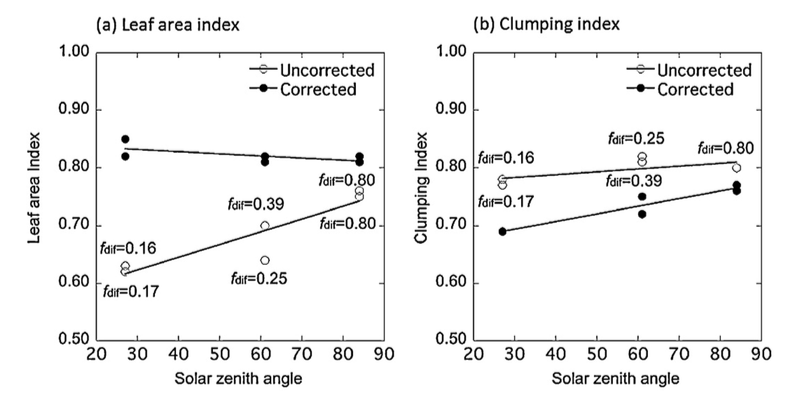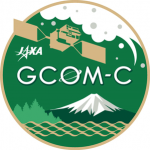Contents
- 1 3D plant canopy radiative transfer model (FLiES)
- 1.1 General description
- 1.2 Case 1:Scattering correction algorithm for Plant Canopy Analyzer
- 1.3 Case 2:Canopy photosynthesis under various atmosphere and canopy conditions
- 1.4 Case 3:Global PAR and SW estimation
- 1.5 Case 4:Leaf area index retrieval for JAXA’s new satellite (GCOM-C)
- 1.6 Related publications
3D plant canopy radiative transfer model (FLiES)
General description
We have been working on the development of a plant canopy radiative transfer model since 2004. Forest Light Environmental Simulator (FLiES) is a coupled 1D atmosphere and 3D plant canopy radiative transfer model. The latest stable version (ver. 2.4) is available in this web site. The version 2.4 can be used for light environment simulation in shortwave (monochromatic, PAR 400-700nm, and shortwave 350-4000nm). To evaluate the uncertainty of the model, FLiES has been participated in the radiative transfer model intercomparison project (RAMI). The details are described in the radiative transfer code. While the stable version is exclusively for shortwave in horizontally flat forest landscapes, there are several additional functions that will be published near future.
- Simulation in longwave (thermal) radiation
- Waveform LiDAR signal
- Sun-Induced Chlorophyll Fluorescence
- Radiative transfer simulation in slope surface
- Utilization of voxel data extracted from TLS and airborne LiDAR
Case 1:Scattering correction algorithm for Plant Canopy Analyzer
Plant Canopy Analyzer, LAI-2200C(LAI-2200C, LiCOR Inc) is a radiation sensor that can quantify the gap fraction from the blue (450nm) light transmission underneath plant canopies. The gap fraction obtained from LAI-2200C is further used to estimate ecosystem parameters such as leaf area index (LAI). The LAI-2000, which is a previous version of Plant Canopy Analyzer, assumes all leaves are black, thus there is no transmission and reflection on leaf surfaces. In fact, there is 3-5% reflection and transmission on leaf surfaces, and ignorance of this small scattering effect may cause a non-negligible impact on LAI estimation. Here, we developed a new scattering correction algorithm for LAI-2200C and the performance of this new algorithm was validated by FLiES via model comparisons. The new scattering correction algorithm is now included in the software fv2200 that LiCOR provided in their web site (https://www.licor.com/env/products/leaf_area/LAI-2200/software.html). The algorithm description is summarized in the following paper.
(Related article) Kobayashi, H., Y. Ryu, D. D. Baldocchi, J. M. Welles, J. N. Norman (2013). On the correct estimation of gap fraction: How to remove scattered radiation in gap fraction measurements? Agricultural and Forest Meteorology, 174-175, 170-183.
Case 2:Canopy photosynthesis under various atmosphere and canopy conditions
Atmospheric constituents and plant canopy architecture alter the spatial variation of light environment within plant canopies. We investigated how the changes in light environments affect canopy scale photosynthesis. Simulated canopy photosynthesis reveals non-linear patterns according to aerosol optical thickness, leaf area index, and crown shape (either sphere or cone).
(Related article) Kobayashi, H. and H. Iwabuchi (2008), A coupled 1-D atmosphere and 3-D canopy radiative transfer model for canopy reflectance, light environment, and photosynthesis simulation in a heterogeneous landscape, Remote Sensing of Environment, 112, 173-185.
Case 3:Global PAR and SW estimation
The FLiES atmospheric module was used to compute the global PAR and shortwave radiation with the MODIS atmospheric products.These PAR and shortwave data were used to simulate the global gross primary production and evapotranspiration with a new model (BESS, Breathing Earth System Simulator). This project was conducted under the collaboration between University of California, Berkeley and Microsoft with a power of Microsoft cloud server, Microsoft Azure.
(Related article) Ryu, Y., D. Baldocchi, H. Kobayashi, C. Ingen, J. Li, A. Black, J. Beringer, E. Gorsel, A. Knohl, B. Law, A. Richardson, O. Roupsard (2011), Integration of MODIS land and atmosphere products with a coupled-process model to estimate gross primary productivity and evapotranspiration from 1 km to global scales, Global Biogeochemical Cycles, 25, GB4017, doi:10.1029/2011GB004053.
Case 4:Leaf area index retrieval for JAXA’s new satellite (GCOM-C)
The JAXA’s new global climate observation satellite, GCOM-C, is planned to be launched in early 2017. FLiES is used as an inversion model for global LAI and FAPAR estimation. Currently, the algorithm development has been in progress.
Related publications
- 押尾晴樹、浅輪貴史、梅干野晁、宮坂 聡 (2015),マルチリターン航空機LiDARデータと植生放射伝達モデルによる都市緑化樹木の日射遮蔽効果の計量化, 日本リモートセンシング学会誌、l. 35 No. 1, pp. 10-23.
- Widlowski, J-L, C. Mio, M. Disney, J. Adams, I. Andredakis, C. Atzberger, J. Brennan, L Busetto, M. Chelle, G Ceccherini, R Colombo, J-F Côté, A. Eenmäe, R. Essery, J-P. Gastellu-Etchegorry, N. Gobron, E.Grau, V. Haverd, L. Homolová, H. Huang, L. Hunt, Kobayashi , B. Koetz, A. Kuusk, J. Kuusk, M. Lang, P. E. Lewis, J. L. Lovell,Z. Malenovsky, M. Meroni, F. Morsdorf, M. Mõttus, T. Nilson, W. Ni‐Meister, B. Pinty, M. Rautiainen, M. Schlerf, B. Somers, J. Stuckens, M. M. Verstraete, W. Yang, F. Zhao, T. Zenone, (2015), The fourth phase of the radiative transfer model intercomparison (RAMI) exercise: Actual canopy scenarios and conformity testing, Remote Sensing of Environment, 169, 418–437
- Osuna, J., D. Baldocchi, Kobayashi , T. E. Dawson, (2015), Seasonal Trends in Photosynthesis and Electron Transport During the Mediterranean Summer Drought in Leaves of Deciduous Oaks, Tree Physiology 00, 1–16 doi:10.1093.
- Maki M. and K. Homma (2014), Empirical Regression Models for Estimating Multiyear Leaf Area Index of Rice from Several Vegetation Indices at the Field Scale, Remote Sensing 2014, 6(6), 4764-4779; doi:10.3390/rs6064764.
- Yang, W., Kobayashi, R. Suzuki, K. N. Nasahara (2014), A Simple Method for Retrieving Understory NDVI in Sparse Needleleaf Forests in Alaska Using MODIS BRDF Data, Remote Sensing, 6, no. 12: 11936-11955.
- Kobayashi H., R. Suzuki, S. Nagai, T. Nakai, Y. Kim (2014), Spatial scale and landscape heterogeneity effects on FAPAR in an open canopy black spruce forest in interior Alaska, IEEE Geoscience and Remote Sensing Letters, Volume 11 , Issue 2, 564-568, 10.1109/LGRS.2013.2278426.
- Widlowski, J-L.., B. Pinty, M. Lopatka, C. Atzberger, D. Buzica, M. Chelle, M. Disney, J-P. Gastellu-Etchegorry, M. Gerboles, N. Gobron, E. Grau, H. Huang, A. Kallel, Kobayashi, P. E. Lewis, W. Qin, M. Schlerf, J. Stuckens, D. Xie (2013), The 4th Radiation Transfer Model Intercomparison (RAMI-IV): Proficiency Testing of Canopy Reflectance Models with ISO-13528, Journal of Geophysical Research, VOL. 118, 1–22, doi:10.1002/jgrd.50497.
- Kobayashi, H., Ryu, D. D. Baldocchi, J. M. Welles, J. N. Norman (2013). On the correct estimation of gap fraction: How to remove scattered radiation in gap fraction measurements? Agricultural and Forest Meteorology, 174-175, 170-183.
- Kobayashi, H., D. Baldocchi, Y. Ryu, Q. Chen, S. Ma, J. Osuna, S. Ustin (2012), Modeling Energy and Carbon Fluxes in a Heterogeneous Oak Woodland: A Three-Dimensional Approach, Agricultural and Forest Meteorology, Agricultural and Forest Meteorology, 152, 83-100.
- Ryu, Y., D. Baldocchi, Kobayashi, C. Ingen, J. Li, A. Black, J. Beringer, E. Gorsel, A. Knohl, B. Law, A. Richardson, O. Roupsard (2011), Integration of MODIS land and atmosphere products with a coupled-process model to estimate gross primary productivity and evapotranspiration from 1 km to global scales, Global Biogeochemical Cycles, 25, GB4017, doi:10.1029/2011GB004053.
- Suzuki, R., H Kobayashi, Delbart, J. Asanuma, T. Hiyama (2011), NDVI responses to the forest canopy and floor from spring to summer observed by airborne spectrometer in eastern Siberia. Remote Sensing of Environment, 115, 3615-3624.
- Widlowski, J-L., B. Pinty, M. Clerici, Y. Dai, M. De Kauwe, K. de Ridder,A. Kallel, Kobayashi , T. Lavergne, W. Ni-Meister, A. Olchev, T. Quaife, S. Wang, W. Yang, Y. Yang, H. Yuan (2011), RAMI4PILPS: An Intercomparison of Formulations for the Partitioning of Solar Radiation in Land Surface Models, Journal of Geophysical Research, 116, G02019, doi:10.1029/2010JG001511.
- Kobayashi, H., N. Delbart, R. Suzuki, K. Kushida (2010), A satellite-based method for monitoring seasonality in the overstory leaf area index of Siberian larch forest, Journal of Geophysical Research, 115, G01002, doi:10.1029/2009JG000939.
- Ryu, Y., O. Sonnentag, T. Nilson, R. Vargas, Kobayashi, R. Wenk, D. D. Baldocchi (2010), How to quantify tree leaf area index in an open savanna ecosystem: A multi-instrument and multi-model approach, Agricultural and Forest Meteorology, 150: 63-76
- 橋本直之, 牧雅康, 田中賢治, 田村正行, 作物農事暦推定にむけたLAI時系列変化パターン抽出方法の検討, 日本リモートセンシング学会誌, 29, pp. 381-391, 2009.
- 小林秀樹 (2008), 針葉樹における分光反射率と葉面積指数の関係:森林の三次元構造とクランピングの影響, 日本リモートセンシング学会誌,28(4),350-356.
- Kobayashi, H. and H. Iwabuchi (2008), A coupled 1-D atmosphere and 3-D canopy radiative transfer model for canopy reflectance, light environment, and photosynthesis simulation in a heterogeneous landscape, Remote Sensing of Environment, 112, 173-185.
- Kobayashi, H, R. Suzuki, S. Kobayashi (2007), Reflectance seasonality and its relation to the canopy leaf area index in an eastern Siberian larch forest: Multi-satellite data and radiative transfer analyses, Remote Sensing of Environment, 106, 238-252.




